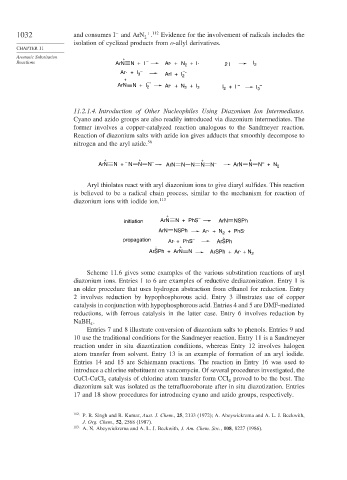Page 1056 - Advanced Organic Chemistry Part B - Reactions & Synthesis
P. 1056
+ 112
1032 and consumes I and ArN . Evidence for the involvement of radicals includes the
−
2
isolation of cyclized products from o-allyl derivatives.
CHAPTER 11
Aromatic Substitution +
.
Reactions ArN N + I – Ar + N + I . 2 I I 2
2
–.
.
Ar + I 3 – ArI + I
2
+ –.
.
ArN N + I 2 Ar + N + I 2 I 2 + I – I 3 –
2
11.2.1.4. Introduction of Other Nucleophiles Using Diazonium Ion Intermediates.
Cyano and azido groups are also readily introduced via diazonium intermediates. The
former involves a copper-catalyzed reaction analogous to the Sandmeyer reaction.
Reaction of diazonium salts with azide ion gives adducts that smoothly decompose to
nitrogen and the aryl azide. 56
+ + + +
–
–
–
–
ArN N + N N N ArN N N N N ArN N N + N 2
Aryl thiolates react with aryl diazonium ions to give diaryl sulfides. This reaction
is believed to be a radical chain process, similar to the mechanism for reaction of
diazonium ions with iodide ion. 113
+
initiation ArN N + PhS – ArN NSPh
.
ArN NSPh Ar + N + PhS .
2
.
–
propagation Ar + PhS – ArSPh
.
. – +
.
ArSPh + ArN N ArSPh + Ar + N
2
Scheme 11.6 gives some examples of the various substitution reactions of aryl
diazonium ions. Entries 1 to 6 are examples of reductive dediazonization. Entry 1 is
an older procedure that uses hydrogen abstraction from ethanol for reduction. Entry
2 involves reduction by hypophosphorous acid. Entry 3 illustrates use of copper
catalysis in conjunction with hypophosphorous acid. Entries 4 and 5 are DMF-mediated
reductions, with ferrous catalysis in the latter case. Entry 6 involves reduction by
NaBH .
4
Entries 7 and 8 illustrate conversion of diazonium salts to phenols. Entries 9 and
10 use the traditional conditions for the Sandmeyer reaction. Entry 11 is a Sandmeyer
reaction under in situ diazotization conditions, whereas Entry 12 involves halogen
atom transfer from solvent. Entry 13 is an example of formation of an aryl iodide.
Entries 14 and 15 are Schiemann reactions. The reaction in Entry 16 was used to
introduce a chlorine substituent on vancomycin. Of several procedures investigated, the
CuCl-CuCl catalysis of chlorine atom transfer form CCl proved to be the best. The
2
4
diazonium salt was isolated as the tetrafluoroborate after in situ diazotization. Entries
17 and 18 show procedures for introducing cyano and azido groups, respectively.
112 P. R. Singh and R. Kumar, Aust. J. Chem., 25, 2133 (1972); A. Abeywickrema and A. L. J. Beckwith,
J. Org. Chem., 52, 2568 (1987).
113
A. N. Abeywickrema and A. L. J. Beckwith, J. Am. Chem. Soc., 108, 8227 (1986).

